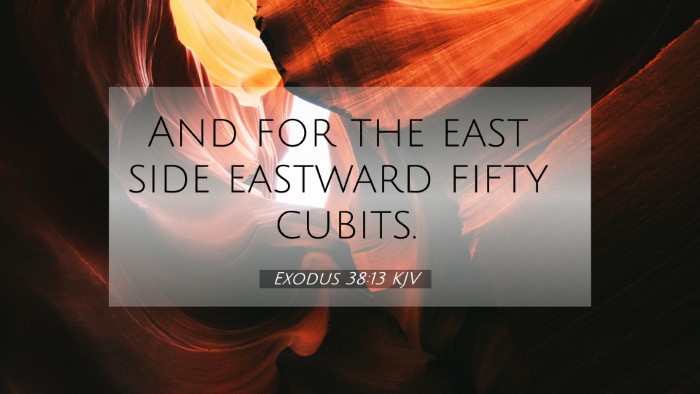Understanding Exodus 38:13
Exodus 38:13 is a pivotal verse within the narrative of the Tabernacle's construction,
highlighting the dimensions and specifications related to its design. This verse states,
"And the length of the board was five cubits, and the breadth of the board was one cubit and a half."
This seemingly straightforward measure carries rich theological and symbolic implications.
Meaning and Significance
The tabernacle represents God’s dwelling among His people, and its detailed design points to
the orderliness and holiness of God. The measurements provided in Exodus 38:13, though technical,
reveal the importance of precision in God's directives. This can be interpreted as an indication
that worship requires attention to divine instructions and the serious nature of approaching God.
Commentary Insights
-
Matthew Henry:
Henry stresses that God's instruction in the measurements of the Tabernacle underscores
the need for order in worship. Each measurement plays a role in communicating the holiness of
God's presence and the need for proper preparation and reverence from the worshippers.
-
Albert Barnes:
Barnes suggests that the specific dimensions reaffirm God's authority and design. He points out
that the intentionality in these measurements reflects the meticulous nature of God's covenant with His people.
-
Adam Clarke:
Clarke adds depth by discussing the spiritual symbolism behind this verse. He conveys that
these measurements not only pertain to the physical structure but also symbolize the integrity and
exclusivity of the relationship between God and His people.
Cross-References
To gain a comprehensive understanding of Exodus 38:13, it is helpful to explore related scriptures
that share similar themes or meanings. Here are several cross-references:
-
Exodus 25:9: "According to all that I show thee, after the pattern of the tabernacle,
and the pattern of all the instruments thereof, even so shall ye make it."
-
Hebrews 8:5: "Who serve unto the example and shadow of heavenly things, as Moses was
admonished of God when he was about to make the tabernacle: for, See, saith he, that thou make all
things according to the pattern shewed to thee in the mount."
-
1 Chronicles 28:11-12: "Then David gave to Solomon his son the pattern of the porch,
and of the houses thereof, and of the treasuries thereof, and of the upper chambers thereof, and of
the inner parlors thereof, and of the place of the mercy seat."
-
Exodus 26:15: "And thou shalt make boards for the tabernacle of shittim wood standing up."
-
Exodus 40:16: "Thus did Moses: according to all that the Lord commanded him, so did he."
-
Romans 12:1: "I beseech you therefore, brethren, by the mercies of God, that ye present
your bodies a living sacrifice, holy, acceptable unto God, which is your reasonable service."
-
John 1:14: "And the Word was made flesh, and dwelt among us, (and we beheld his glory,
the glory as of the only begotten of the Father,) full of grace and truth."
Thematic Connections
The thematic connections between Exodus 38:13 and other Bible verses create a rich tapestry of
understanding. The ongoing themes of divine instruction, holiness, and God’s presence resonate throughout
the scriptures.
Applications for Cross-Referencing
For anyone interested in deepening their biblical study, utilizing tools for Bible cross-referencing
is essential. The following are ways to explore the Bible's interconnected themes:
- Using a Bible concordance to trace themes and keywords.
- Engaging in cross-reference Bible study methods.
- Identifying thematic parallels through various Bible reference resources.
Conclusion
In summary, Exodus 38:13 might present as a mere specification of dimensions in the Tabernacle, but
through careful examination and comparison with other scriptures, it emerges as a profound testimony to
God's meticulous design and the nature of holiness. The inter-Biblical dialogue encouraged by cross-referencing
enriches our understanding and enhances our spiritual walk.


